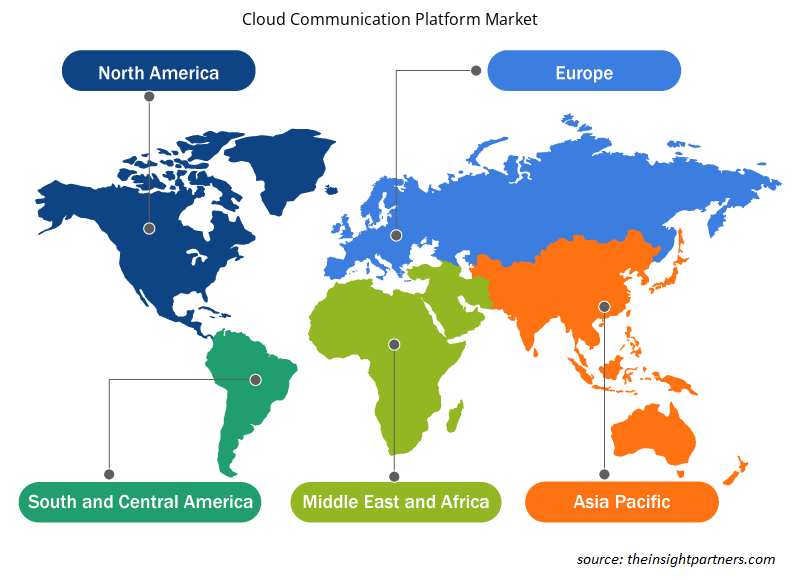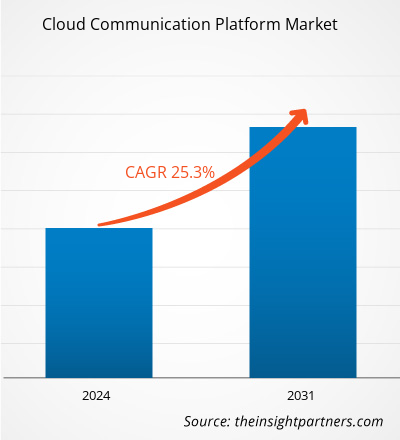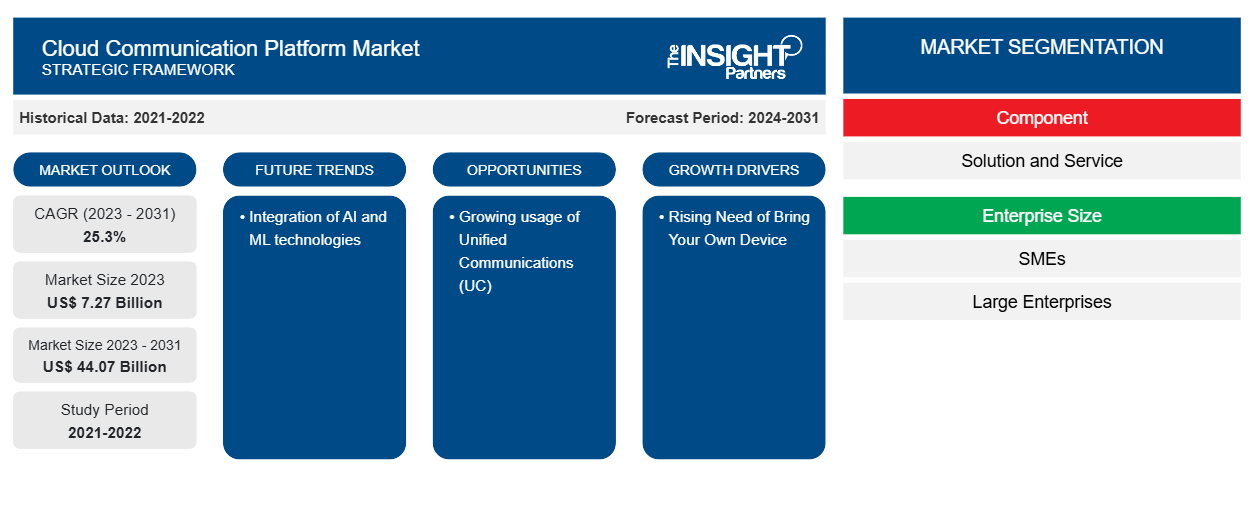Si prevede che la dimensione del mercato della piattaforma di comunicazione cloud raggiungerà i 44,07 miliardi di dollari entro il 2031, rispetto ai 7,27 miliardi di dollari del 2023. Si prevede che il mercato registrerà un CAGR del 25,3% nel periodo 2023-2031. È probabile che l'integrazione delle tecnologie AI e ML rimanga una tendenza chiave nel mercato.
Analisi di mercato della piattaforma di comunicazione cloud
La tendenza crescente a portare i propri dispositivi (BYOD), con l'enfasi sull'offerta di opzioni di lavoro flessibili, sta favorendo la crescita del mercato delle piattaforme di comunicazione cloud.
Panoramica del mercato della piattaforma di comunicazione cloud
L'espressione "cloud" si riferisce a un complesso sistema di piattaforme informatiche, reti e applicazioni interconnesse a cui gli utenti accedono tramite Internet. Invece di richiedere un enorme computer (server) sul posto di lavoro per archiviare e scambiare file, tutte le risorse di elaborazione, archiviazione, networking e applicazione sono accessibili tramite Internet. I principali fornitori forniscono una grande quantità di potenza di elaborazione, di cui il tuo team utilizza solo una percentuale. Ciò consente al team di accedere solo alla quantità di potenza di elaborazione o archiviazione di cui ha bisogno in un dato momento, anziché dover gestire un server di grandi dimensioni. Ciò consente al team IT di concentrarsi su ciò che è più essenziale per l'organizzazione anziché sulle complicazioni di garantire che i server siano sicuri, raffreddati e mantenuti. L'utilizzo di una piattaforma di comunicazioni cloud ridurrà notevolmente i costi aumentando al contempo l'agilità aziendale.
Personalizza questo report in base alle tue esigenze
Riceverai la personalizzazione gratuita di qualsiasi report, comprese parti di questo report, o analisi a livello nazionale, pacchetto dati Excel, oltre a usufruire di grandi offerte e sconti per start-up e università
-
Scopri le principali tendenze di mercato in questo rapporto.Questo campione GRATUITO includerà analisi di dati che spaziano dalle tendenze di mercato alle stime e alle previsioni.
Driver e opportunità di mercato della piattaforma di comunicazione cloud
Crescente necessità di portare il proprio dispositivo per favorire il mercato
La politica BYOD (Bring Your Own Device) consente ai dipendenti di utilizzare i propri dispositivi personali per scopi aziendali. Questa pratica comporta l'archiviazione dei dati sul cloud. I dati possono essere visualizzati ovunque, in qualsiasi momento, senza alcuna difficoltà. La crescente tendenza del BYOD nel settore aziendale è un fattore chiave per il mercato delle piattaforme di comunicazione cloud in tutto il mondo. La mobilità è stata indicata come una delle tre tendenze di collaborazione più importanti per le PMI (Piccole e Medie Imprese), con circa il 67% dei dipendenti che ora gestisce i propri dispositivi al lavoro e quasi il 39% delle aziende che adotta una politica BYOD formale. Abilitando i dispositivi dei dipendenti con servizi cloud , le PMI forniscono ai propri dipendenti l'accesso a tutto ciò di cui hanno bisogno per svolgere le proprie attività, sia a casa che in ufficio.
Inoltre, secondo il report di Cisco Systems, Inc., il concetto BYOD aumenta la produttività dei dipendenti. Mostra anche che il 36% degli utenti è risultato iper-produttivo. I fornitori di piattaforme di comunicazione cloud stanno continuamente costruendo infrastrutture per supportare l'implementazione BYOD nel settore aziendale collegando applicazioni, come i social media aziendali e i portali di policy di sicurezza, molti dei quali portano verso servizi di mobilità gestiti (MMS).
Crescente utilizzo delle Comunicazioni Unificate (UC)
La tecnologia UC consente l'integrazione di software che supporta sia le comunicazioni in tempo reale (RTC), come il telefono su IP (VoIP), sia le comunicazioni asincrone, come la chat persistente, assicurando che l'utente finale abbia un accesso semplice e rapido a tutti gli strumenti importanti in un ambiente coerente da qualsiasi posizione fisica o dispositivo digitale. Molti prodotti UC incorporano, o addirittura si basano su, strumenti di collaborazione di gruppo con processi incentrati sulla messaggistica e capacità collaborative come la condivisione e l'annotazione di file in tempo reale. Questi sistemi UC di nuova generazione sono spesso noti come comunicazioni e collaborazione unificate (UCC).
Analisi della segmentazione del rapporto di mercato della piattaforma di comunicazione cloud
I segmenti chiave che hanno contribuito alla derivazione dell'analisi di mercato della piattaforma di comunicazione cloud sono i componenti, le dimensioni dell'azienda e il settore.
- In base al componente, il mercato è segmentato per soluzione e servizi. Il segmento delle soluzioni ha detenuto una quota di mercato significativa nel 2023.
- In base alle dimensioni dell'impresa, il mercato è segmentato in PMI e grandi imprese. Il segmento delle grandi imprese ha detenuto una quota di mercato maggiore nel 2023.
- In base al settore, il mercato è segmentato in BFSI, IT e telecomunicazioni, sanità, vendita al dettaglio, governo, istruzione e altri. Il segmento IT e telecomunicazioni ha detenuto la quota maggiore del mercato nel 2023.
Analisi della quota di mercato della piattaforma di comunicazione cloud per area geografica
L'ambito geografico del rapporto di mercato sulle piattaforme di comunicazione cloud è suddiviso principalmente in cinque regioni: Nord America, Asia Pacifico, Europa, Medio Oriente e Africa, Sud e Centro America.
Il Nord America ha dominato il mercato delle piattaforme di comunicazione cloud nel 2023. Questa dominanza è legata al crescente utilizzo di servizi basati su cloud nella regione. La presenza di vari provider di servizi basati su cloud contribuisce anche alla crescita del mercato in Nord America. Inoltre, il successo di provider basati su cloud come Google ha dimostrato l'efficacia e la convenienza delle piattaforme cloud. Le comunicazioni cloud forniscono servizi voce, dati e video, offrendo ai consumatori più alternative rispetto ai provider locali o regionali. L'attrattiva delle comunicazioni cloud incoraggia la crescita dei sistemi di comunicazione cloud.
Approfondimenti regionali sul mercato delle piattaforme di comunicazione cloud
Le tendenze regionali e i fattori che influenzano il Cloud Communication Platform Market durante il periodo di previsione sono stati ampiamente spiegati dagli analisti di Insight Partners. Questa sezione discute anche i segmenti e la geografia del Cloud Communication Platform Market in Nord America, Europa, Asia Pacifico, Medio Oriente e Africa e Sud e Centro America.

- Ottieni i dati specifici regionali per il mercato della piattaforma di comunicazione cloud
Ambito del rapporto di mercato sulla piattaforma di comunicazione cloud
| Attributo del report | Dettagli |
|---|---|
| Dimensioni del mercato nel 2023 | 7,27 miliardi di dollari USA |
| Dimensioni del mercato entro il 2031 | 44,07 miliardi di dollari USA |
| CAGR globale (2023-2031) | 25,3% |
| Dati storici | 2021-2022 |
| Periodo di previsione | 2024-2031 |
| Segmenti coperti |
Per componente
|
| Regioni e Paesi coperti |
America del Nord
|
| Leader di mercato e profili aziendali chiave |
|
Densità dei player del mercato della piattaforma di comunicazione cloud: comprendere il suo impatto sulle dinamiche aziendali
Il mercato del Cloud Communication Platform Market sta crescendo rapidamente, spinto dalla crescente domanda degli utenti finali dovuta a fattori quali l'evoluzione delle preferenze dei consumatori, i progressi tecnologici e una maggiore consapevolezza dei vantaggi del prodotto. Con l'aumento della domanda, le aziende stanno ampliando le loro offerte, innovando per soddisfare le esigenze dei consumatori e capitalizzando sulle tendenze emergenti, il che alimenta ulteriormente la crescita del mercato.
La densità degli operatori di mercato si riferisce alla distribuzione di aziende o società che operano in un particolare mercato o settore. Indica quanti concorrenti (operatori di mercato) sono presenti in un dato spazio di mercato in relazione alle sue dimensioni o al valore di mercato totale.
Le principali aziende che operano nel mercato delle piattaforme di comunicazione cloud sono:
- ?8X8, INC
- Italiano: Avaya Inc.
- ChiamaFuoco
- Cisco Systems, Inc.
- NetFortris
- Vonage
Disclaimer : le aziende elencate sopra non sono classificate secondo un ordine particolare.

- Ottieni una panoramica dei principali attori del mercato delle piattaforme di comunicazione cloud
Notizie di mercato e sviluppi recenti sulla piattaforma di comunicazione cloud
Il mercato delle piattaforme di comunicazione cloud viene valutato raccogliendo dati qualitativi e quantitativi dopo la ricerca primaria e secondaria, che include importanti pubblicazioni aziendali, dati associativi e database. Di seguito sono elencati alcuni degli sviluppi nel mercato delle piattaforme di comunicazione cloud:
- Vonage, leader mondiale nelle comunicazioni cloud che aiuta le aziende ad accelerare la loro trasformazione digitale e parte di Ericsson, ha ampliato la sua soluzione Vonage Premier for Service Cloud Voice per includere l'integrazione con Salesforce Einstein Conversation Insights. Queste analisi e approfondimenti basati sull'intelligenza artificiale consentiranno ai marchi di migliorare l'esperienza degli agenti e dei clienti con funzionalità di chiamata globali intelligenti, il tutto all'interno di Salesforce Service Cloud Voice. (Fonte: Vonage, comunicato stampa, maggio 2024)
- Cisco si basa sulla strategia della piattaforma di sicurezza e presenta la piattaforma di rete unificata. (Fonte: Cisco, comunicato stampa, giugno 2023)
Copertura e risultati del rapporto di mercato sulla piattaforma di comunicazione cloud
Il rapporto "Dimensioni e previsioni del mercato della piattaforma di comunicazione cloud (2021-2031)" fornisce un'analisi dettagliata del mercato che copre le seguenti aree:
- Dimensioni e previsioni del mercato della piattaforma di comunicazione cloud a livello globale, regionale e nazionale per tutti i segmenti di mercato chiave coperti dall'ambito
- Tendenze del mercato della piattaforma di comunicazione cloud e dinamiche di mercato come driver, vincoli e opportunità chiave
- Analisi dettagliata delle cinque forze PEST/Porter e SWOT
- Analisi di mercato della piattaforma di comunicazione cloud che copre le principali tendenze di mercato, il quadro globale e regionale, i principali attori, le normative e i recenti sviluppi del mercato
- Analisi del panorama industriale e della concorrenza che copre la concentrazione del mercato, l'analisi della mappa di calore, i principali attori e gli sviluppi recenti per il mercato della piattaforma di comunicazione cloud
- Profili aziendali dettagliati
- Analisi storica (2 anni), anno base, previsione (7 anni) con CAGR
- Analisi PEST e SWOT
- Valore/volume delle dimensioni del mercato - Globale, Regionale, Nazionale
- Industria e panorama competitivo
- Set di dati Excel
Report recenti
Testimonianze
Motivo dell'acquisto
- Processo decisionale informato
- Comprensione delle dinamiche di mercato
- Analisi competitiva
- Analisi dei clienti
- Previsioni di mercato
- Mitigazione del rischio
- Pianificazione strategica
- Giustificazione degli investimenti
- Identificazione dei mercati emergenti
- Miglioramento delle strategie di marketing
- Aumento dell'efficienza operativa
- Allineamento alle tendenze normative























 Ottieni un campione gratuito per - Mercato delle piattaforme di comunicazione cloud
Ottieni un campione gratuito per - Mercato delle piattaforme di comunicazione cloud